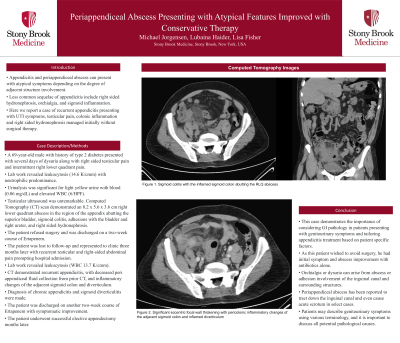Monday Poster Session
Category: Colon
P1991 - Periappendiceal Abscess Presenting With Atypical Features Improved With Conservative Therapy
Monday, October 28, 2024
10:30 AM - 4:00 PM ET
Location: Exhibit Hall E

Has Audio

Michael Jorgensen, MD
Stony Brook Medicine
Stony Brook, NY
Presenting Author(s)
Michael Jorgensen, MD, Lisa Fisher, MD, Lubaina Haider, MD
Stony Brook Medicine, Stony Brook, NY
Introduction: Appendicitis and periappendiceal abscess can present with atypical symptoms depending on the degree of adjacent structure involvement. Less common sequelae of appendicitis include right sided hydronephrosis, orchialgia, and sigmoid inflammation. Here we report a case of recurrent appendicitis presenting with UTI symptoms, testicular pain, colonic inflammation and right sided hydronephrosis managed initially without surgical therapy.
Case Description/Methods: A 69-year-old male with history of type 2 diabetes presented with several days of dysuria along with right sided testicular pain and intermittent right lower quadrant pain. Lab work revealed leukocytosis (14.6 K/cmm) with neutrophilic predominance. Urinalysis was significant for light yellow urine with blood (0.06 mg/dL) and elevated WBC (6/HPF). Testicular ultrasound was unremarkable. Computed Tomography (CT) scan demonstrated an 8.2 x 5.6 x 3.6 cm right lower quadrant abscess in the region of the appendix abutting the superior bladder, sigmoid colitis, adhesions with the bladder and right ureter, and right sided hydronephrosis.
The patient refused surgery and was discharged on a two-week course of Ertapenem. The patient was lost to follow-up and represented to clinic three months later with recurrent testicular and right-sided abdominal pain prompting hospital admission. Lab work revealed leukocytosis (WBC 13.7 K/cmm). CT demonstrated recurrent appendicitis, with decreased peri appendiceal fluid collection from prior CT, and inflammatory changes of the adjacent sigmoid colon and diverticulum. Diagnosis of chronic appendicitis and sigmoid diverticulitis were made. The patient was discharged on another two-week course of Ertapenem with symptomatic improvement. The patient underwent successful elective appendectomy months later.
Discussion: This case demonstrates the importance of considering GI pathology in patients presenting with genitourinary symptoms and tailoring appendicitis treatment based on patient specific factors. As this patient wished to avoid surgery, he had initial symptom and abscess improvement with antibiotics alone. Orchialgia or dysuria can arise from abscess or adhesion involvement of the inguinal canal and surrounding structures. Periappendiceal abscess has been reported to tract down the inguinal canal and even cause acute scrotum in select cases. Patients may describe genitourinary symptoms using various terminology, and it is important to discuss all potential pathological causes.
Disclosures:
Michael Jorgensen, MD, Lisa Fisher, MD, Lubaina Haider, MD. P1991 - Periappendiceal Abscess Presenting With Atypical Features Improved With Conservative Therapy, ACG 2024 Annual Scientific Meeting Abstracts. Philadelphia, PA: American College of Gastroenterology.
Stony Brook Medicine, Stony Brook, NY
Introduction: Appendicitis and periappendiceal abscess can present with atypical symptoms depending on the degree of adjacent structure involvement. Less common sequelae of appendicitis include right sided hydronephrosis, orchialgia, and sigmoid inflammation. Here we report a case of recurrent appendicitis presenting with UTI symptoms, testicular pain, colonic inflammation and right sided hydronephrosis managed initially without surgical therapy.
Case Description/Methods: A 69-year-old male with history of type 2 diabetes presented with several days of dysuria along with right sided testicular pain and intermittent right lower quadrant pain. Lab work revealed leukocytosis (14.6 K/cmm) with neutrophilic predominance. Urinalysis was significant for light yellow urine with blood (0.06 mg/dL) and elevated WBC (6/HPF). Testicular ultrasound was unremarkable. Computed Tomography (CT) scan demonstrated an 8.2 x 5.6 x 3.6 cm right lower quadrant abscess in the region of the appendix abutting the superior bladder, sigmoid colitis, adhesions with the bladder and right ureter, and right sided hydronephrosis.
The patient refused surgery and was discharged on a two-week course of Ertapenem. The patient was lost to follow-up and represented to clinic three months later with recurrent testicular and right-sided abdominal pain prompting hospital admission. Lab work revealed leukocytosis (WBC 13.7 K/cmm). CT demonstrated recurrent appendicitis, with decreased peri appendiceal fluid collection from prior CT, and inflammatory changes of the adjacent sigmoid colon and diverticulum. Diagnosis of chronic appendicitis and sigmoid diverticulitis were made. The patient was discharged on another two-week course of Ertapenem with symptomatic improvement. The patient underwent successful elective appendectomy months later.
Discussion: This case demonstrates the importance of considering GI pathology in patients presenting with genitourinary symptoms and tailoring appendicitis treatment based on patient specific factors. As this patient wished to avoid surgery, he had initial symptom and abscess improvement with antibiotics alone. Orchialgia or dysuria can arise from abscess or adhesion involvement of the inguinal canal and surrounding structures. Periappendiceal abscess has been reported to tract down the inguinal canal and even cause acute scrotum in select cases. Patients may describe genitourinary symptoms using various terminology, and it is important to discuss all potential pathological causes.
Disclosures:
Michael Jorgensen indicated no relevant financial relationships.
Lisa Fisher indicated no relevant financial relationships.
Lubaina Haider indicated no relevant financial relationships.
Michael Jorgensen, MD, Lisa Fisher, MD, Lubaina Haider, MD. P1991 - Periappendiceal Abscess Presenting With Atypical Features Improved With Conservative Therapy, ACG 2024 Annual Scientific Meeting Abstracts. Philadelphia, PA: American College of Gastroenterology.
